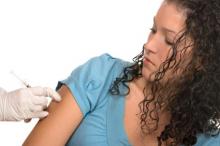The increases in human papillomavirus immunization trailed far behind that of the other two recommended adolescent and preadolescent vaccinations between 2009 and 2010, according to new data from the Centers for Disease Control and Prevention.
"I’ve got some bad news to report about our nation’s health. The national teen vaccination data that we’re releasing today show that far too few U.S. girls are getting the HPV vaccine, a vaccine we know protects them against cervical cancer," said Dr. Melinda Wharton, deputy director of the CDC’s National Center for Immunization and Respiratory Diseases, in a press briefing held Aug. 25.
The data come from the National Immunization Survey, in which randomly selected parents of more than 19,000 teens aged 13-17 years were asked about receipt of the HPV vaccine, the tetanus, diphtheria, acellular pertussis vaccine (Tdap), and the meningococcal conjugate vaccine (MenACWY). Coverage from 2009 to 2010 among 11- to 12-year-olds increased from 55.6% to 68.7% for Tdap, from 53.6% to 62.7% for MenACWY, from 44.3% to 48.7% for one dose of HPV vaccine, and from 26.7% to 32.0% for the full three-dose series of HPV vaccine (MMWR 2011;60:1117-23).
Of the girls who began the HPV series, 30% did not receive all three doses. Completion of the series was lower among blacks and Hispanics than among whites, and also was lower among those below the poverty line, Dr. Wharton noted.
Overall, the improvement in Tdap and meningococcal vaccine was good. "There’s room for improvement with both, but we’re making good progress. In contrast, with HPV vaccine we’re just not doing as well, and coverage is lagging very far behind where we are with the other two vaccines [that] we recommend for use with young adolescents." This is important because the vaccine protects against cervical cancer, which the CDC estimates is diagnosed in 12,000 women in the U.S. each year, and from which 4,000 die annually, she said.
More than 35 million doses of HPV vaccine have been distributed, and the safety record is good, Dr. Wharton added.
Among the factors contributing to the HPV lag is the fact that the HPV vaccine is a multidose series, whereas the other two are given in a single dose. In addition, there are missed opportunities to vaccinate, there is lack of awareness among parents, and the vaccine is not receiving a strong recommendation from physicians. "Providers can make a strong recommendation to administer the vaccine at 11-12 years of age, because we know that this makes an enormous impact on parents’ decisions to vaccinate. If they vaccinate every girl in their practice on time, and schedule appointments for the full series, we know that will help," she said.
In response to a reporter’s question about what physicians should say to parents who believe their daughter is too young to receive a vaccine against a sexually transmitted infection, Dr. Wharton said the vaccine needs to be given prior to initiation of sexual activity. "That’s why we recommended it at age 11-12 years. We want to give it long before it’s needed."
She concluded, "The good news is, we can do better at this. We’ve got in our possession a very powerful tool, a vaccine that prevents cancer. We can improve things, starting right now. If we all take actions to protect girls starting today, we’ll have generations of women who will never be diagnosed with cervical cancer, and that would be a great outcome."
As a CDC employee, Dr. Wharton has no financial disclosures.


